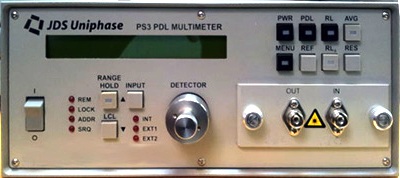
|
|
The JDS Uniphase PS3050 Polarization Dependent Loss Multimeters are the fastest and most accurate multimeters available. They measure polarization dependent loss (PDL) of single-mode fiberoptic components using either an internal laser or an external source. The multimeters measure the loss of a device under test for four independent input polarization states. The PDL and the average loss over all polarization states are calculated using the Mueller matrix, internationally standardized under IEC (613)00-3-12. The multimeters easily and rapidly change from measuring PDL and insertion loss (IL) to measuring return loss (RL) or power. The PDL and IL are measured and displayed simultaneously in less than two seconds. The multimeters have a sophisticated optical design that compensates for changes in optical power at the internal reference detector. The design ensures accurate loss measurements regardless of drift in the source power or the coupling efficiency of the input light through the polarization state controller. The integrated PDL standard source is particularly convenient for verifying the meter's calibration. An external tunable laser or two fixed laser sources can be selected for various wavelength measurements. The multimeters are ideal for PDL-sensitive components, such as isolators, DWDMs, fiber Bragg gratings (FBGs), optical circulators, switches, attenuators, couplers, and other devices for which high test accuracy and optimum production speed are crucial. Built-in laser type Fabry-Perot: 1550 nm. Fiber type: 9/125 µm SM. PDL and IL Measurement Resolution: 0.01, 0.001, or 0.0001 dB. Repeatability PDL: ± (0.001+ 5 % of PDL) dB. Dynamic range PDL range: 0-5 dB. Without optical return loss.
|